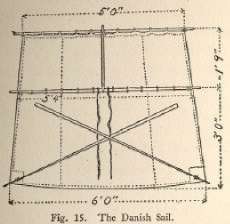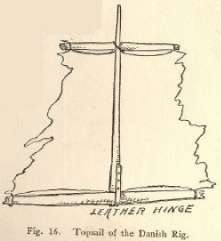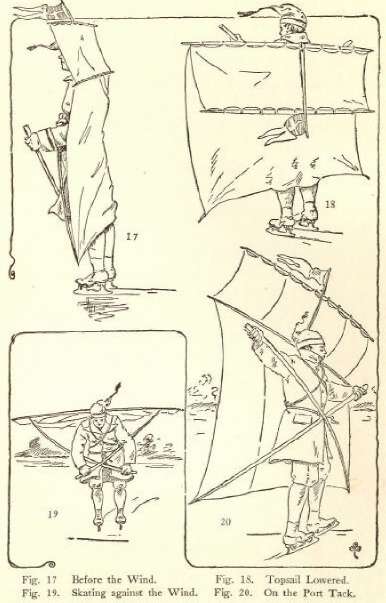The Danish Sail
Description
This section is from the book "The Scientific American Boy", by A. Russell Bond. Also available from Amazon: The Scientific American Boy.
The Danish Sail
But the most satisfactory sail we found to be the Danish sail, though it was not until we had served quite a long apprenticeship and sustained many pretty bad falls that we mastered the art of manipulating these sails properly. Our ideas on this sail were obtained from a French illustrated paper which Dutchy Van Syckel picked up in his father's library. This sail was formed with a topsail so arranged that it could be lowered when the wind was too strong. The dimensions of the sail as we made it are given in the drawing (Fig. 15). The top of the sail was lashed to a spar, which was connected by a short stick to another spar tied to the mainsail about eighteen inches lower down. The sail was strengthened with an extra strip of cloth along the lower spar, and the tie strings were applied in

Fig. 15. The Danish Sail.

Fig. 16. Topsail of the Danish Rig.

Fig. 17. Before the Wind.
Fig. 19. Skating against the Wind.
Fig. 18. Topsail Lowered. Fig. 20. On the Port Tack.
the usual way. The connecting stick, or topmast we may call it, was hinged to the lower spar by means of a short piece of leather strap, which was passed round the spar in the form of a loop and its two ends nailed to the bottom of the topmast. The topmast extended above the upper spar a short distance, and to this we fastened the flag which our society had adopted. A couple of strong cords were secured to the center spar to provide for fastening the sail onto the skater. Tied to the lower corners of the mainsail were two sticks which were used for guiding the sail when in flight.
The different methods of sailing with this rig are shown in Figs. 17-20. When sailing with the wind the skater would stand very erect, bending backward in proportion as the wind blew fresher. By inclining the sail in one direction or the other, the skater could tack to port or starboard. When moving against the wind by skating in the usual way, the body was bent forward in such manner that the sail lay horizontal, so that it would not offer a purchase for the wind.
Continue to:


